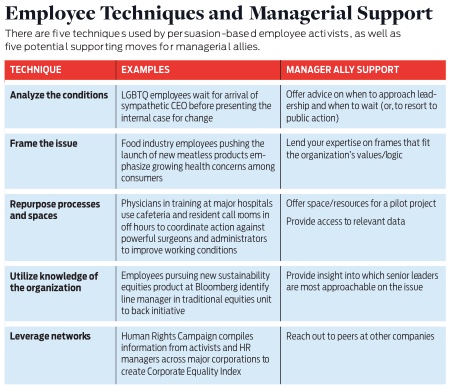News, ideas & inspiration from industry leaders

Your Workplace Activism Playbook: Winning Moves for Employees and Managers
An article in the Winter 2021 issue of the Stanford Social Innovation Review—“Business Disruption from the Inside Out: A playbook for Employee Activists and advice for leaders”—is causing a stir with our colleagues in the field. Shelly Thompson from Maddie’s Fund originally shared this article with me, and I immediately recognized this as an extremely timely issue for many leaders in the animal welfare sector.
Employee activism—individuals engaging in collective action to address a societal problem and make change in the workplace—is nothing new. Pioneering groups back in the 1970s organized themselves to advocate for equal rights and call for policies that did not discriminate. These groups included The Corporate Few, started by a group of Black managers at Xerox, and The Women of AT&T.
But employee activism is more relevant than ever, as we face the urgent challenge to create cultures of equity and inclusion, and to dismantle programs and processes that perpetuate systemic racism. And, to be honest, as organizations scramble to get started in DEI work and as we stumble through this territory together….
I encourage you to read the article by Drs. Forrest Briscoe and Abhinav Gupta. I have to admit I had a few heart palpitations, reading how some of the employees used disruptive techniques to call for change. But, as Dr. Briscoe points out, 90% of the workplace changes his research looked at came about through less visible but no less powerful persuasion tactics.
For me, it goes back to the importance of organizational culture, and the importance of empowering and supporting our teams. As Gina Knepp of Michelson’s Found Animals Foundation told me, “As I reflect back on my time at Front Street Animal Shelter, many of the wonderful changes we made were suggested by staff and volunteers. It’s so important for leaders to reflect on recommendations by staff to improve operations and lifesaving. There are so many people in this field who are silently ignored or too fearful to suggest improvements.”
With that in mind, here are some powerful tactics from Dr. Briscoe’s and Dr. Gupta’s Playbook for Employee Activism. They share winning moves for those who want to make change, and for those who manage employee activists.
5 Winning Moves for Employees
Key components of changemaking for employee activists:
1. Analyze the conditions.
Ask yourself, “Is this the right time and place for action in regard to the issue I’m concerned about?”
Let’s use a timely example, and say you want to update your adoptions application and eliminate questions designed to discriminate.What are the chances of success? What are the potential risks? How does your proposed change align with your organization’s goals?
2. Frame your issue.
Do this by emphasizing a problem, and showcasing your proposed change as the solution.
You can frame your issue in different ways, depending on the audience. A business framing might show a bottom-line impact. “Put a dollar value to it,” suggests Dr. Briscoe. In this case, you might use demographics to demonstrate a bigger adopter pool (and potential volunteer and donor pool) your more inclusive application represents. What could this mean for revenue and resources?
A moral framing will demonstrate that your proposed change is the right thing to do. Equality and equity are human rights—what does it mean, especially with today’s urgent need to address systemic racism, if your policies reflect baked-in biases that exclude entire groups of people?
3. Repurpose processes and spaces.
One of the key challenges will be to find a place where you can talk freely without fear of retaliation. Consider connecting via an online discussion platform or, for those onsite, meeting in the conference or staff room when it’s free. Also, consider existing infrastructure—is there an existing cross-functional team that discusses changes to policies and organizational culture?
4. Utilize knowledge of the organization.
This one’s about knowing office politics and informal culture, and tapping the influencers in your organization. Drs. Briscoe and Gupta call them your “internal champions who are sympathetic to your cause and are able to influence others.”
It’ll be crucial to look for other organizations and colleagues who have already made the changes you’re looking to make. Says Dr. Briscoe, “Find some success stories to make the case for your change.” In the case of rewriting your adoptions policy, you’ll have so many rich examples in our industry to tap into.
5. Leverage networks.
This is the time to make use of The Association’s Member Directory, or post a question in one of The Association’s Private (Members Only) Facebook groups. Here’s where you can exchange tactical information, and experiences about what has worked in the past. Search for peer-reviewed research that supports your case. Continuing with our example, share studies and data related to open adoptions, and ask colleagues to share their forms, samples and data.

3 Winning Moves for Managers
Managers, here’s what you can do to support your changemakers:
1. Consider being an ally.
- Think through how decisions are made in your organization and lend your expertise on framing an issue. If decisions to adoption programs are typically based on data, share relevant numbers if you have access to them, or connect activists to those who do. Reach out to your senior leadership-level colleagues at other orgs for advice.
- Offer resources for a pilot project to help demonstrate the viability of a change. This can be small—in our example, that could mean lending support for a small fee-waived event, adopter/community survey, or month-long trial of adoptions without landlord checks.
- Provide guidance on which senior decisionmakers will be most receptive to the issue.
2. Listen to employee activists with an open mind.
This one is crucial, whether or not you are in a position to provide allyship. Talk with other internal and external stakeholders for more information, i.e. ask the adoption department about their processes and how decisions are made. And always, always, practice civility and transparency—respect for others in the workplace is paramount.
3. Think longer-term.
As Dr. Briscoe points out, “There is no longer a line separating business from social issues.” Social justice is now playing out right in the workplace, so it’s important to consider how activist’s goals relate to your organization’s mission. This is not simple—think it through and debate it and frame the issues in various ways. It’s also important to build relationships with organizations and groups that have credibility in the issues you are discussing.
Right now in our world, and in our field, we have an important opportunity to help each other. If employee activists have brought about change at your organization, I’d love to hear your experience. Let’s continue to learn from and support each other in this critical work.
Learn More
Article: Business Disruption from the Inside Out: A playbook for Employee Activists and advice for leaders
Webinar with Dr. Briscoe: Employee Activism: A New Kind of Disruption on Vimeo



